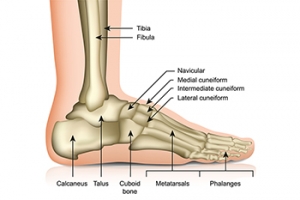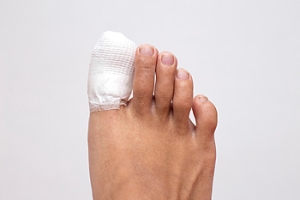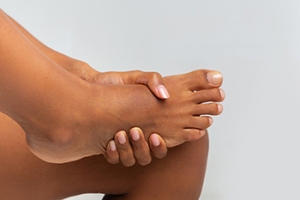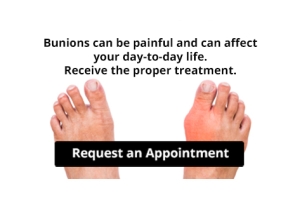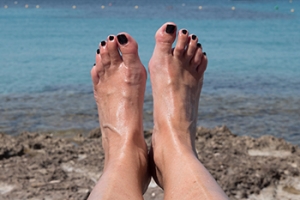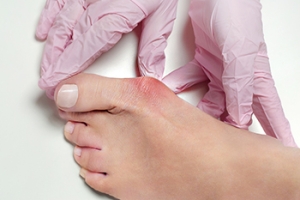Items filtered by date: November 2022
How the Ankle Joint Works
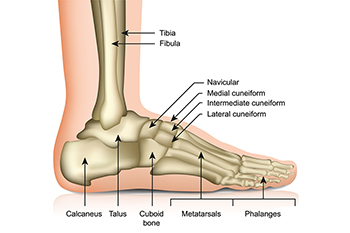
One of the key joints in the body is the talocrural region, also known as the ankle joint. This joint, which connects the leg to the foot, is crucial to walking, standing, and running. The main bone in the ankle joint is the talus. Because it is not attached to any muscles, the talus is reliant on the bones surrounding it. Other bones that may be thought of as ankle bones actually belong to the lower leg or foot. These consist of the tibia and fibula of the leg, as well as the calcaneus of the heel and the navicular, which lies on top of the foot. These bones work together with the talus to allow the foot to point and flex. Another main function of the talus is to transmit force from the tibia to the calcaneus, or heel bone. Holding all these bones together is a network of ligaments. Keeping the ankle joint healthy includes wearing footwear that provides ample support and cushioning to avoid chronic ankle pain that can interfere with all your daily activities. If you have any pain or discomfort in the ankle, please visit a podiatrist for an examination and diagnosis.
Ankle pain can be caused by a number of problems and may be potentially serious. If you have ankle pain, consult with Dr. Kenneth Donovan from Advanced Care Foot and Ankle. Our doctor will assess your condition and provide you with quality foot and ankle treatment.
Ankle pain is any condition that causes pain in the ankle. Due to the fact that the ankle consists of tendons, muscles, bones, and ligaments, ankle pain can come from a number of different conditions.
Causes
The most common causes of ankle pain include:
- Types of arthritis (rheumatoid, osteoarthritis, and gout)
- Ankle sprains
- Broken ankles
- Achilles tendinitis
- Achilles tendon rupture
- Stress fractures
- Bursitis
- Tarsal tunnel syndrome
- Plantar fasciitis
Symptoms
Symptoms of ankle injury vary based upon the condition. Pain may include general pain and discomfort, swelling, aching, redness, bruising, burning or stabbing sensations, and/or loss of sensation.
Diagnosis
Due to the wide variety of potential causes of ankle pain, podiatrists will utilize a number of different methods to properly diagnose ankle pain. This can include asking for personal and family medical histories and of any recent injuries. Further diagnosis may include sensation tests, a physical examination, and potentially x-rays or other imaging tests.
Treatment
Just as the range of causes varies widely, so do treatments. Some more common treatments are rest, ice packs, keeping pressure off the foot, orthotics and braces, medication for inflammation and pain, and surgery.
If you have any questions, please feel free to contact one of our offices located in Warren, Livingston, and Toms River, NJ . We offer the newest diagnostic and treatment technologies for all your foot care needs.
Toe Pain and Biking

Toe pain can be an annoyance for a variety of different individuals. Different kinds of activities can increase one’s susceptibility to toe pain or exacerbate existing toe pain. Cycling/biking is one such activity. If you are a cyclist that feels pain in their toes after cycling, then it is possible that your cycling shoes are simply too tight. Often, cycling shoes are more restrictive. Since one’s feet can expand in size during a session of cycling, this can make the feet feel as if they do not fit in the shoes. Toe pain might result from this. As a general rule, the toes should have sufficient space in one’s cycling shoes to move freely. This can potentially reduce the extent to which one might experience toe pain. If you are a cyclist, contact a podiatrist today for more information.
Toe pain can disrupt your daily activities. If you have any concerns, contact Dr. Kenneth Donovan of Advanced Care Foot and Ankle. Our doctor can provide the care you need to keep you pain-free and on your feet.
What Causes Toe Pain?
Most severe toe pain is caused due to a sports injury, trauma from dropping something heavy on the toe, or bumping into something rigid. Other problems can develop over time for various reasons.
Toe pain can be caused by one or more ailments. The most common include:
- Trauma
- Sports injury
- Wearing shoes that are too tight
- Arthritis
- Gout
- Corns and calluses
- Hammertoe
- Bunions
- Blisters
- Ingrown toenails
- Sprains
- Fractures (broken bones)
- Dislocations
When to See a Podiatrist
- Severe pain
- Persistent pain that lasts more than a week
- Signs of infection
- Continued swelling
- Pain that prevents walking
Diagnosis
In many cases the cause of toe pain is obvious, but in others, a podiatrist may want to use more advanced methods to determine the problem. These can range from simple visual inspections and sensation tests to X-rays and MRI scans. Prior medical history, family medical history, and any recent physical traumatic events will all be taken into consideration for a proper diagnosis.
Treatment
Treatments for toe pain and injuries vary and may include shoe inserts, padding, taping, medicines, injections, and in some cases, surgery. If you believe that you have broken a toe, please see a podiatrist as soon as possible.
If you have any questions please feel free to contact one of our offices located in Warren, Livingston, and Toms River, NJ . We offer the newest diagnostic tools and technology to treat your foot and ankle needs.
What Are Systemic Diseases?

Systemic diseases are health problems that can affect various body parts. Two systemic health issues that frequently affect the feet are diabetes and rheumatoid arthritis. In both cases, treating the disease can help prevent or relieve foot symptoms. Wearing bigger shoes and using molded inserts can also help in preventing the need for surgery, which might be necessary if symptoms are severe. If you suffer from a health condition that is negatively affecting your feet and causing you discomfort, seek the counsel of a podiatrist who can help you feel more comfortable.
When dealing with systemic disease of the feet, it is extremely important to check the affected areas routinely so that any additional problems are caught quickly. If you have any concerns about your feet and ankles contact Dr. Kenneth Donovan from Advanced Care Foot and Ankle. Our doctor will assist you with all of your podiatric needs.
Systemic Diseases of the Feet
Systemic diseases affect the whole body, and symptoms usually are displayed in the feet. This condition can make a patient’s ability to walk unbearable. Systemic diseases include gout, diabetes mellitus, neurological disorders, and arthritis.
Gout – is caused by an excess of uric acid in the body. Common symptoms include pain, inflammation, and redness at the metatarsal/phalangeal joint of the base big toe. Gout can be treated by NSAIDs to relieve pain and inflammation, and other drugs that lower the acid levels in the body.
Diabetes mellitus – is an increase in the level of blood sugar that the body cannot counteract with its own insulin. Failure to produce enough insulin is a factor in Diabetes.
Diabetes of the Feet
Diabetic Neuropathy – may lead to damaged nerves and affect the feet through numbness and loss of sensation.
Peripheral Vascular Disease – can restrict the blood flow to the feet, and often times lead to amputation of the feet.
If you have any questions please feel free to contact one of our offices located in Warren, Livingston, and Toms River, NJ . We offer the newest diagnostic and treatment technologies for all your foot and ankle needs.
Bodyboarding and Foot Pain

Many beachgoers like to spend their time in the ocean, catching waves in an activity that is known as bodyboarding. When an individual goes bodyboarding, they sometimes use bodyboarding fins (or flippers) on their feet to help with swimming. However, wearing these flippers can sometimes negatively impact the feet. For example, if the flippers are particularly low quality, they can easily rub up against the feet, causing friction that might lead to the development of blisters. This chaffing can be quite uncomfortable for your feet. If you are a bodyboarder and you want to wear flippers, contact your podiatrist to ensure that you are doing everything that you can to properly protect your feet.
Sports related foot and ankle injuries require proper treatment before players can go back to their regular routines. For more information, contact Dr. Kenneth Donovan of Advanced Care Foot and Ankle. Our doctor can provide the care you need to keep you pain-free and on your feet.
Sports Related Foot and Ankle Injuries
Foot and ankle injuries are a common occurrence when it comes to athletes of any sport. While many athletes dismiss the initial aches and pains, the truth is that ignoring potential foot and ankle injuries can lead to serious problems. As athletes continue to place pressure and strain the area further, a mild injury can turn into something as serious as a rupture and may lead to a permanent disability. There are many factors that contribute to sports related foot and ankle injuries, which include failure to warm up properly, not providing support or wearing bad footwear. Common injuries and conditions athletes face, including:
- Plantar Fasciitis
- Plantar Fasciosis
- Achilles Tendinitis
- Achilles Tendon Rupture
- Ankle Sprains
Sports related injuries are commonly treated using the RICE method. This includes rest, applying ice to the injured area, compression and elevating the ankle. More serious sprains and injuries may require surgery, which could include arthroscopic and reconstructive surgery. Rehabilitation and therapy may also be required in order to get any recovering athlete to become fully functional again. Any unusual aches and pains an athlete sustains must be evaluated by a licensed, reputable medical professional.
If you have any questions please feel free to contact one of our offices located in Warren, Livingston, and Toms River, NJ . We offer the newest diagnostic and treatment technologies for all your foot and ankle needs.
Bunions Are a Common Foot Condition

The probability is high for developing a bunion. Research has shown that one-third of Americans will eventually have bunions, and it is easier to treat in the beginning stages. It is defined as a bony growth that gradually forms on the side of the big toe, and can cause discomfort while walking. It happens from genetic reasons, or, most commonly from wearing shoes that do not have enough room for the toes to move freely in. Calluses and corns may form on untreated bunions, and larger shoes may need to be purchased that can accommodate the bunion. Relief may be found when the correct width of shoes are worn, and high heels may have to be eliminated from frequent wearing. Bunions will typically not diminish on their own, but they may be easier to live with when the right shoes are worn. If the bunion is making daily activities difficult to accomplish, surgery may be a necessary option for permanent relief. It is strongly suggested that you consult a podiatrist who can provide you with the answers you may be seeking.
If you are suffering from bunions, contact Dr. Kenneth Donovan of Advanced Care Foot and Ankle. Our doctor can provide the care you need to keep you pain-free and on your feet.
What Is a Bunion?
A bunion is formed of swollen tissue or an enlargement of boney growth, usually located at the base joint of the toe that connects to the foot. The swelling occurs due to the bones in the big toe shifting inward, which impacts the other toes of the foot. This causes the area around the base of the big toe to become inflamed and painful.
Why Do Bunions Form?
Genetics – Susceptibility to bunions are often hereditary
Stress on the feet – Poorly fitted and uncomfortable footwear that places stress on feet, such as heels, can worsen existing bunions
How Are Bunions Diagnosed?
Doctors often perform two tests – blood tests and x-rays – when trying to diagnose bunions, especially in the early stages of development. Blood tests help determine if the foot pain is being caused by something else, such as arthritis, while x-rays provide a clear picture of your bone structure to your doctor.
How Are Bunions Treated?
- Refrain from wearing heels or similar shoes that cause discomfort
- Select wider shoes that can provide more comfort and reduce pain
- Anti-inflammatory and pain management drugs
- Orthotics or foot inserts
- Surgery
If you have any questions, please feel free to contact one of our offices located in Warren, Livingston, and Toms River, NJ . We offer the newest diagnostic and treatment technologies for all your foot care needs.


